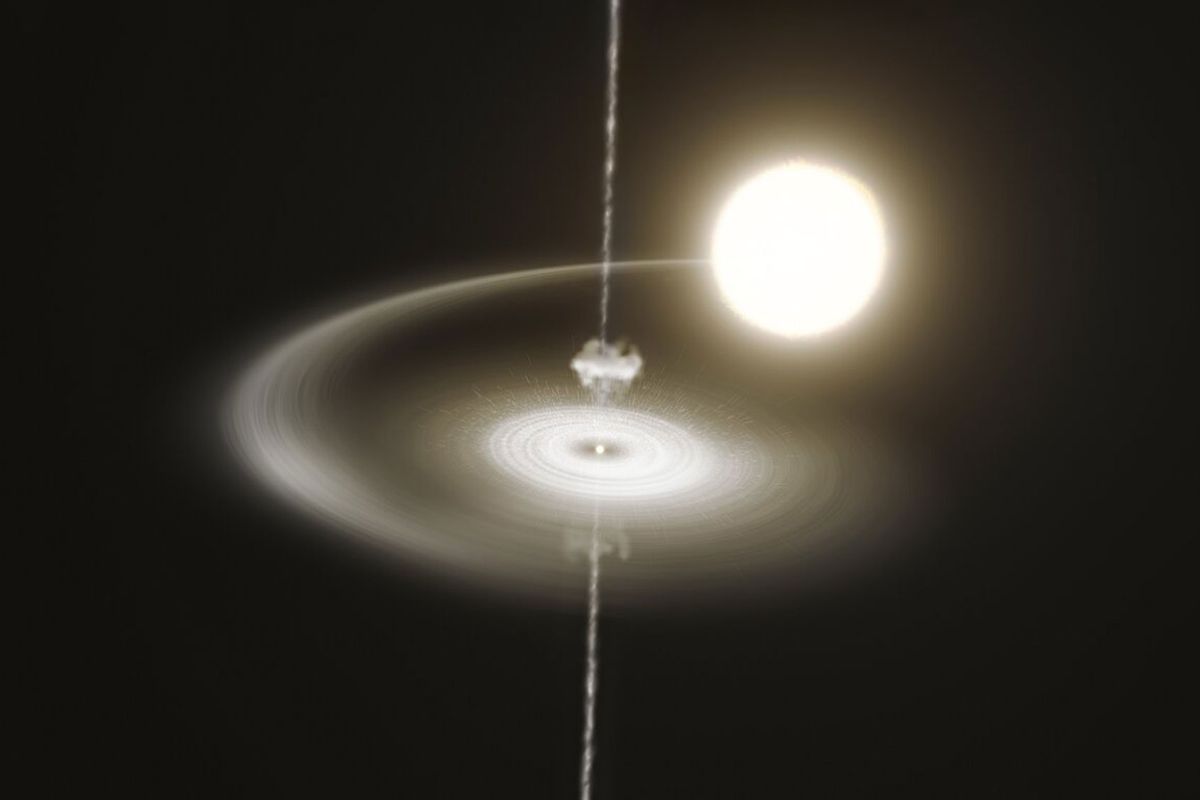In the Sextans constellation 4,500 light-years away, a dead, magnetic star rotates 592 times in a second, emanating electromagnetic beams like an oscillating lighthouse out into the universe. But over time, this pulsar stopped pulsating light and began flashing on and off like a light switch instead. For years, it was unclear why, but a new study suggests jet expulsions of hot matter burped out like cosmic cannonballs are behind it.
This pulsar, PSR J1023+0038, or J1023 for short, orbits another low-mass star, from which it has gradually been sucking matter over time and to which it is inching closer. Stolen matter collects in a ring around J1023, but since this accumulation process began, the energy emanating from the pulsar began switching between what researchers call a “high” mode of emanating X-rays, ultraviolet and visible light, and a “low” mode in which it goes dark. The pulsar is in the “high” mode about 70% of the time, with each “low” mode lasting anywhere between 30 seconds to many minutes.
Over time, this pulsar stopped pulsating light and began flashing on and off like a light switch instead. For years, it was unclear why.
In a new study published in Astronomy & Astrophysics, researchers found the switching was actually being caused by huge blasts of matter rapidly torn away from the pulsar, said study author Cristina Baglio, Ph.D., a researcher at NYU Abu Dhabi.
“In particular, the observations with the Atacama Large Millimeter/submillimeter Array (ALMA) were crucial, allowing us to observe for the first time for this source fast microwave flashes, marking the propagation of blobs of matter, similar to cosmic cannonballs, into space,” Baglio told Salon in an email.
Pulsars are a type of neutron star formed when massive stars collapse after running out of fuel. They are relatively small, measuring about 20 kilometers across; they have magnetic fields stronger than anything on Earth; and they rotate on their axis hundreds of times per second.
Because the pulsar observed is rotating so fast and is so magnetic, it generates particles that move nearly at the speed of light. When enough matter collects around the pulsar from its neighboring star, these charged particles heat the matter up and burst out, causing the pulsar to brighten in its high mode. Eventually, jet propulsions and strong winds from within the pulsar eject the heated matter like cosmic cannonballs. Once this matter has been removed, the star dims and switches to low mode. Then the cycle begins again.
Want more health and science stories in your inbox? Subscribe to Salon’s weekly newsletter Lab Notes.
When enough matter collects around the pulsar from its neighboring star, these charged particles heat the matter up and burst out, causing the pulsar to brighten.
“The collision of high-energy charged particles from the pulsar wind with the inflowing matter in the disc increases the ionization level of the disc,” the authors wrote. “As a result, the inflowing matter is drawn into the pulsar magnetic field and accelerated, producing a compact jet of plasma that streams out along the direction of the pulsar magnetic field lines.”
Baglio’s team used a dozen telescopes from the European Southern Observatory (ESO) facilities in Chile and the XMM Newton, Swift, NICER and Hubble Space Telescope satellites to monitor the pulsar over two nights in 2021 through various energy spectrums, including the electromagnetic spectrum, radiowaves and X-rays.
What they saw was that the switches between the two modes took place over the course of about 10 seconds — comparable to Usain Bolt’s recent 100-meter world record. However, their equipment can only capture data at a certain speed, and Baglio hypothesized that it could actually be switching as quickly as every 0.1 seconds.
The switches between the two modes took place over the course of about 10 seconds — comparable to Usain Bolt’s recent 100-meter world record.
“[That] corresponds approximately to the timescale it takes for an eye to blink,” Baglio said. “This timescale is impressive if you consider that in that short time span, a huge amount of matter is torn away and ejected from the system at nearly the speed of light.”
The findings can help explain how matter behaves when it’s subjected to strong gravitational, magnetic and radiation fields and provide insights into the laws of physics under extreme circumstances that can’t be replicated on Earth, said study author Francesco Coti Zelati, Ph.D., a researcher at the Institute of Space Sciences. In some ways, this behavior is similar to what happens in certain black hole systems, according to the study. But it’s unclear if this happens in other types of neutron stars, Coti Zelati said.
“The mode-switching behavior observed in the pulsar … challenges our traditional understanding of how pulsars interact with their environment,” Coti Zelati told Salon in an email. “Overall, understanding the behavior of pulsars better can give us insights into extreme states of matter, magnetic fields stronger than anything we can generate on Earth and the behavior of binary star systems where matter is actively being transferred from one object to another.”
Read more
about neutron stars

